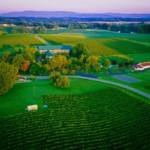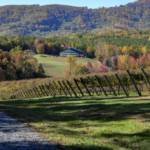North Carolina has a burgeoning wine trail — when did they go from tobacco to wine?
Before Napa there was North Carolina, at one time the country’s largest producer of wine. At the turn of the (last) century, there were 25 wineries in North Carolina before the state voted to go dry in 1908. Some simply left the state and moved to the sunny climes of California, where the wine industry was picking up.
And then Prohibition came into the picture. The winegrowers who were left closed up the wine shop and turned these vast vineyards into tobacco farms in order to make ends meet. Now, with tobacco use generally on the decrease, these once lush, verdant farms are again sprouting scrappy grape vines. Winemakers have reversed the exodus to California and have begun to move to North Carolina to plant vines and reinvigorate the wine industry in the Tar Heel State.

Winery owner, Chuck Jones, moved to North Carolina after spending time in San Francisco and throughout California’s wine country. Jones owns the Jones von Drehle winery along with his wife, Diana, and sister- and brother-in-law, Ronnie and Raymond. “Several folks ask why in the world we opened a winery up here and not closer to a major center, to which we reply, ‘This is where the grapes want to be.’ And that has proven to be the case. We believe this site provides every opportunity to grow fruit that rivals California,” Jones tells LuxeGetaways.
Winemakers Louis and Carrie Jeroslow and Nick and Jennifer White—co-owners of Elkin Creek Vineyard in the Yadkin Valley—all met, married and moved back to North Carolina after working with the Blue Man Group. Jeroslow describes the mountain foothills where Elkin Creek Vineyard is located as “the Goldilocks of nature—not too hot, not too cold, not too sunny, not too rainy—it’s just right.” Jeroslow continues, “This region shows the qualities of Old World Europe. It’s in its infancy and we can feel the potential and want to be a part of it.”
Take a tasting tour through small towns, meet local wine makers and sip a variety of unique blends…
In 2011, there were about 100 vineyards in the state; now, there are over 200 and the number keeps growing. Late in 2016 another American Viticultural Area (AVA) was designated—the Appalachian High Country—giving the state its fifth AVA.
This means that there are an awful lot of acres to tread and bushels of wine to taste as these regions begin to hit their stride: North Carolina is the only wine-growing region in the whole wide world that grows every major grape type, from Scuppernong to Syrah. (The Scuppernong grape, we might add, is the state fruit of North Carolina and part of the Muscadine tribe of grapes: a deliciously sweet and fruity fresh grape that makes a similar-tasting wine. Whether you’re a newbie to wine or an experienced oenophile, chances are good that you haven’t tried this one yet.)
To navigate these five regions, your best bet is to pick a city and explore from there: Winston-Salem is a good starting point for the Yadkin Valley, Swan Creek and the Appalachian High Country, which is the newest AVA; Greensboro sets you up for the Haw River; and head to Asheville to take in the Upper Hiwassee Highlands trail. The North Carolina Wine and Grape Council has set up both self-guided tours that you can customize and download, or you can follow one of their five wine trails.
If you haven’t visited North Carolina for the wine recently, it might be a good time to start planning your own getaway! https://www.ncwine.org.
American Viticultural Areas (AVAs)
Yadkin Valley (est. 2002) Located in northwestern N.C. and home to approximately 400 acres of vineyard
Swan Creek (est. 2008) A sub-region of the Yadkin Valley AVA and home to six wineries
Haw River Valley (est. 2009) Located in central N.C. and home to six wineries
Upper Hiwassee Highlands (est. 2014) Situated in two counties, it is home to five wineries in southwestern N.C.
Appalachian High Country (est. 2016) Comprising five counties and six wineries in the N.C. mountains






